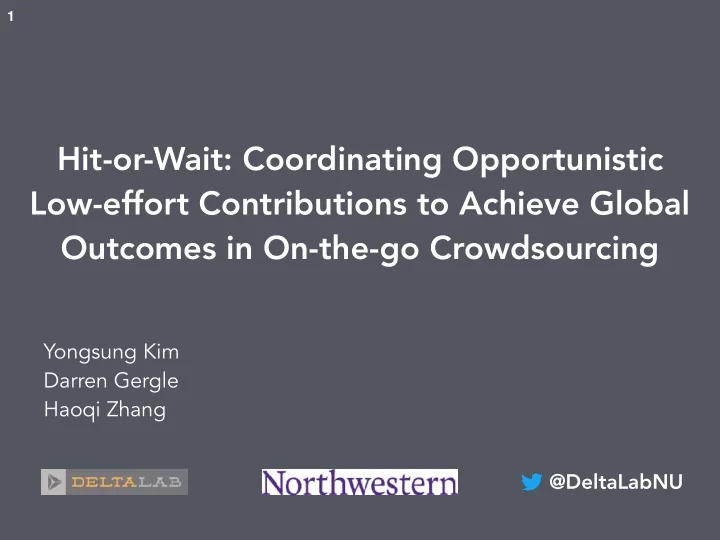

� 1 Hit-or-Wait: Coordinating Opportunistic Low-effort Contributions to Achieve Global Outcomes in On-the-go Crowdsourcing Yongsung Kim Darren Gergle Haoqi Zhang @DeltaLabNU
� 2 Imagine that you lost your wallet on your way to the venue
� 3 How might we leverage CHI attendee’s existing routine and route to help you find your wallet?
� 4 Opportunistic/Pull-based
� 5 Directed/Push-based Nope, already headed to the party
� 6 Our goal: leverage existing route to notify when it is convenient for helpers
� 7 Our goal: and achieve globally effective outcomes
� 8 Conceptual approach • Achieve globally effective outcomes in physical crowdsourcing by indirectly coordinating opportunistic contributions with people on-the-go.
� 9 Opportunistic Our Helper Convenience Approach Approach Sadilek et al. ICWSM 2013 Kim et al. HCOMP 2016 Doryab et al. Ubicomp 2018 Directed Approach Teodoro et al. CHI 2014 Thebault-Spieker et al. CSCW 2015 Quality of service
� 10 When do we notify people of a task?
� 11 When do we notify people of a task? • we do not want to notify all the time, but only notify at the “best moment”
� 12 When do we notify people of a task? • we do not want to notify all the time, but only notify at the “best moment” • we can optimize task assignment [Kandappu et al. CSCW 2016] , but people may not accept the task and we also do not know where they may go next
� 13 When do we notify people of a task? • we do not want to notify all the time, but only notify at the “best moment” • we can optimize task assignment [Kandappu et al. CSCW 2016] , but people may not accept the task and we also do not know where they may go next • we may send low-valued tasks or miss opportunities to notify.
� 14 Opportunistic Hit-or-Wait • Uses decision-theory to decide **on-the-fly** whether to notify a helper of a task right now or wait for better opportunities in the future, in ways that reason both about system needs across tasks and about a helper’s changing patterns of mobility.
� 15 Hit-or-Wait Example
� 16 Wait
� 17 Hit!
� 18 Our approach: Modeling a sequence of Hit-or- Wait decisions with a Markov Decision Process (MDP) • State s: task location • Reward function R(s, a): value of notifying a task at state s • Transition function P(s’|s): likelihood of reaching state s’ from state s. • Action: {hit, wait} • if hit, it moves to terminal state • if wait, it moves to next state
� 19 Modeling a sequence of Hit-or-Wait decisions with a Markov Decision Process (MDP)
� 20 1. Encode value of notifying a helper of a task likelihood of finding item search count
� 21 2. Model likelihood of reaching next location from current location
� 22 3. Compare the expected value of notifying now with the expected value from making a decision later if we wait
� 23 Studies • A simulation study • A field deployment
� 24 Simulation study • compare hit-or-wait with other approaches • understand how hit-or-wait mechanism works • understand how model accuracy affects the performance
� 25 Simulation setup • Dataset: 5,983 running routes from 2,419 users in RunKeeper • Measure: • Search Quality: likelihood of finding an item given searches • Conditions: • Hit-or-Wait • Node Counting • Optimal solution (full knowledge of routes)
� 26 Hit-or-Wait maximizes user contributions without explicit coordination
� 27
� 28 A field deployment • How does Hit-or-Wait work in practice? • What are some failure cases in practice? • What are users’ perception of their contributions?
� 29 Field deployment setup • 10-day study with 25 users (13M, 12F) in lost and found Scenario • Dataset: Pre-study (N=11) with location tracking • Measures: • Search quality • Value of hit or wait decisions • Conditions: • Hit-or-Wait • Optimal (full knowledge)
� 30 Results • 248 notifications sent and 60 searches conducted along their routes (24.19% acceptance rate) • Among the searches, 4 different participants found 4 items out of the 9 search requests
� 31 Hit-or-Wait reached 84% of optimal solution in practice
� 32 Hit-or-Wait made effective wait decisions
� 33 Failure cases in misprediction
� 34 Failure cases in misprediction
� 35 Follow-up interviews • 7 participants who helped at least once • Hit-or-Wait example visualizations •
� 36 Users wanted to have better understanding in how they contributed to the global goal • “Maybe also having information like if someone does find the item, then I would know I was being helpful...I was helping part of that even if I wasn’t the exact person to find it.” — P7
� 37 Applicability of Hit-or-Wait • Volunteer-based peer-to-peer services where the system goal is to effectively provide help for each other. • Low-effort sensing and community sensing where the goal is to ensure data coverage and details.
� 38 Decision theory as a way to support communities Context-sensitive task notifications [Kim et al. HCOMP 2016, Ikeda et al. CHI 2017, Doryab et al. Ubicomp 2018]
� 39 Decision theory as a way to support communities Context-sensitive task notifications [Kim et al. HCOMP 2016, Ikeda et al. CHI 2017, Doryab et al. Ubicomp 2018] This work: Individual-level Coordination
� 40 Decision theory as a way to support communities Context-sensitive task notifications [Kim et al. HCOMP 2016, Ikeda et al. CHI 2017, Doryab et al. Ubicomp 2018] This work: Individual-level Coordination Future work: Community-level Coordination
� 41 Takeaways • Hit-or-Wait allows volunteers to go about their routine, but indirectly coordinates their contributions to achieve better system needs and helper convenience. • Introduces ways to use decision-theoretic approach to not only optimize but to support convenient interactions
Hit-or-Wait: Coordinating Opportunistic � 42 Low-effort Contributions to Achieve Global Outcomes in On-the-go Crowdsourcing Hit me at @DeltaLabNU or Wait and chat after the session Yongsung Kim Darren Gergle Haoqi Zhang @DeltaLabNU
Recommend
More recommend